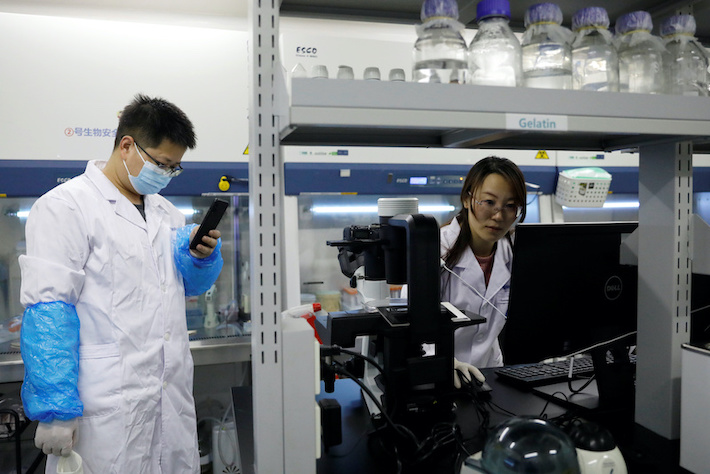Asia’s biggest countries are extending their capacity in critical global research sectors, according to a new report.
China has increased its lead in 64 critical technologies, according to a new report by the Australian Strategic Policy Institute (ASPI), while “India is also emerging as a key centre of global research innovation and excellence” to become a science and technology power,” it said.
The ASPI report focuses on high-impact research, as a key indicator of potential science and technology capability. It covers crucial fields such as defence, space, energy, the environment, artificial intelligence (AI), biotechnology, robotics, cyber, computing, advanced materials and key quantum tech areas.
ALSO SEE: Dutch PM Wary Of ASML Impact From More China Tech Curbs
The ASPI said there had been a “stunning shift” from two decades ago, when the US led in 60 of 64 technologies in the five years from 2003 to 2007.
China led in just three technologies at that time but its “exceptional gains” meant it “is now the lead country in 57 of 64 technologies in 2019-2023,” the ASPI said in the executive summary, while the US now leads in just seven.
The launch in 2015 of Beijing’s ‘Made in China 2025’ plan, which saw massive direct state funding for research and development in key technologies, “established the level of ambition that the Chinese government had for technological supremacy — a determination that hasn’t abated since then,” the report said.
And this year, China plans a 10% boost to its budget for science and technology, raising it to $51.5 billion – money will go toward basic and applied research, plus national strategic science and technology tasks, it said, while large outlays are made in complementary areas such as industry policy, upgrading supply chains and manufacturing.
A key reason for China’s rise in some fields stemmed from the fact high‐impact research by pioneering science and tech powers such as the US, Japan, the UK and Germany had flatlined, so research and scientific strengths built over many decades was at risk.
In the early 2000s, the US was the leading PV manufacturer and top publisher of cited publications in photovoltaics (PV), the chip tech that converts solar energy into electricity, the report said, while Japan and Germany were the second and third ranked countries in manufacturing and research.
But following the Global Financial Crisis in 2007-08, when the US private sector took a hit, China’s PV research grew increasingly important, especially after the end of government subsidies in Japan and Germany.
Over the past five years India’s PV research has ranked as third highest and “it remains on an upward trajectory,” ASPI said, “having exceeded the US in high‐impact research outputs in 2022.”
However, the US, the UK and countries from Europe, northeast Asia and the Middle East had “maintained hard-won strengths in high-impact research in some key technology areas,” it said.
Risk of research monopolies in critical fields
The Australian institute said it has continued to assess the “risk of countries holding a monopoly in research for some critical technologies, based on the share of high-impact research output and the number of leading institutions the dominant country has.”
The number of technologies classified as “high-risk” had jumped from 14 technologies last year to 24, it said, and that “China is the lead country in all of the fields classed as high-risk.”
“Worryingly, the technologies newly classified as high risk includes many with defence applications, such as radar, advanced aircraft engines, drones, swarming and collaborative robots and satellite positioning and navigation.”
The ASPI report described China’s lead in electric batteries research as “stunning” and said it was “perhaps the most pronounced high‐impact research advantage China holds out of the 64 critical technologies” that ASPI tracks.
China’s lead in recent high‐impact research in electric batteries was matched by its prominent role in global battery manufacturing capacity, it said, as six out of the top 10 EV battery manufacturers were Chinese, with CATL and BYD leading the way.
Meanwhile, US tech giants such as Google, IBM, Microsoft and Meta all had leading or strong positions in AI, quantum and computing technologies.
Key government agencies and national labs such as National Aeronautics and Space Administration (NASA) continued to excel in space and satellite technologies.
The Chinese Academy of Sciences (CAS) was “by far the world’s highest performing institution,” with ASPI’s Critical Tech Tracker finding it had leading research in 31 of 64 critical technologies.
ASPI said its finding were a reminder that gaining and maintaining scientific and research excellence “isn’t a tap that can be turned on and off”. When countries stop investing in R&D and manufacturing capability they risk losing long-term competitive advantage, such as 5G technologies.
“In a range of essential sectors, democratic nations risk losing hard-won, long-term advantages in cutting-edge science and research — the crucial ingredient that underpins much of the development and advancement of the world’s most important technologies.
That could mean democratic nations aren’t well positioned to take advantage of new and emerging technologies.
- Jim Pollard
ALSO SEE:
IBM Closing China Research Labs, Will Lay Off Over 1,000 Staff
China-Based Inventors Have Filed 1,020 Patents With US Funding
China’s Critical Minerals Blockade Risks Global Chip Shortage
US Tech Firms Face ‘Death Spiral’ From New China Curbs: Lawmakers
China Testing Bigger Cargo Drones And Helicopter Taxis
US Releases Detailed Rules For Export Curbs on AI Chips to China
Huawei, US-Sanctioned Firms Win as China Dumps Western Tech
China Leads the US on Scientific Research Papers – Guardian
US Imposes Export Restrictions On China Research Institutes
China’s Hypersonic Missiles Advantage Has West Worried























